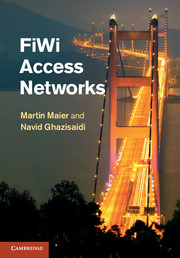Book contents
- Frontmatter
- Contents
- List of figures
- List of tables
- Preface
- Acknowledgments
- Part I Introduction
- Part II Fiber access networks
- Part III Wireless access networks
- Part IV FiWi access networks
- 10 RoF vs. R&F networks
- 11 Architectures
- 12 Network planning and reconfiguration
- 13 Techno-economic analysis
- 14 Network coding
- 15 Optical and wireless protection
- 16 Hierarchical frame aggregation
- 17 Routing and QoS continuity
- 18 Smart grid communications
- References
- Index
17 - Routing and QoS continuity
from Part IV - FiWi access networks
Published online by Cambridge University Press: 05 January 2012
- Frontmatter
- Contents
- List of figures
- List of tables
- Preface
- Acknowledgments
- Part I Introduction
- Part II Fiber access networks
- Part III Wireless access networks
- Part IV FiWi access networks
- 10 RoF vs. R&F networks
- 11 Architectures
- 12 Network planning and reconfiguration
- 13 Techno-economic analysis
- 14 Network coding
- 15 Optical and wireless protection
- 16 Hierarchical frame aggregation
- 17 Routing and QoS continuity
- 18 Smart grid communications
- References
- Index
Summary
The wireless mesh front-end of fiber-wireless (FiWi) access networks provides multiple paths to route traffic coming from and going to the optical backhaul. In this chapter, we review a variety of recently proposed routing algorithms that aim at optimizing the network performance in terms of delay, throughput, packet loss, load balancing, and other important metrics such as path availability and power consumption. The considered routing algorithms cover either only the wireless front-end or both the wireless and optical domains of FiWi access networks. Furthermore, this chapter elaborates on various techniques to provide service differentiation and end-to-end guaranteed quality-of-service (QoS) and enable QoS continuity across the optical–wireless interface of FiWi broadband access networks.
Wireless routing algorithms
In this section, we describe various recently proposed routing algorithms for the wireless front-end of FiWi access networks. All of the discussed wireless routing algorithms aim at finding the optimal path through a wireless mesh front-end by meeting one or more objectives.
DARA
A pro-active routing algorithm, referred to as the delay-aware routing algorithm (DARA), which minimizes the average packet delay between a router and any wireless mesh gateway was presented in (Sarkar et al. [2007b, 2008]). DARA is a link-state routing algorithm, where each wireless mesh router and gateway periodically advertises their link conditions (i.e., traffic intensity and link capacity with time stamp) in link state advertisement (LSA) messages. Upon reception of an LSA message, each router/gateway predicts the traffic intensity, which is used to predict the state of the corresponding link until the next LSA message arrives.
Information
- Type
- Chapter
- Information
- FiWi Access Networks , pp. 196 - 206Publisher: Cambridge University PressPrint publication year: 2011
